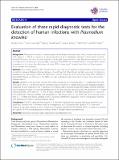Files in this item
Evaluation of three rapid diagnostic tests for the detection of human infections with Plasmodium knowlesi
Item metadata
| dc.contributor.author | Foster, Deshka | |
| dc.contributor.author | Cox Singh, Janet | |
| dc.contributor.author | Mohamad, Dayang S. A. | |
| dc.contributor.author | Krishna, Sanjeev | |
| dc.contributor.author | Chin, Pek P. | |
| dc.contributor.author | Singh, Balbir | |
| dc.date.accessioned | 2014-05-06T14:01:00Z | |
| dc.date.available | 2014-05-06T14:01:00Z | |
| dc.date.issued | 2014-02-18 | |
| dc.identifier | 116317427 | |
| dc.identifier | aa99c888-a713-4f7e-b15f-2d0a982f7b56 | |
| dc.identifier | 000332774300003 | |
| dc.identifier | 84896738280 | |
| dc.identifier | 000332774300003 | |
| dc.identifier.citation | Foster , D , Cox Singh , J , Mohamad , D S A , Krishna , S , Chin , P P & Singh , B 2014 , ' Evaluation of three rapid diagnostic tests for the detection of human infections with Plasmodium knowlesi ' , Malaria Journal , vol. 13 , 60 . https://doi.org/10.1186/1475-2875-13-60 | en |
| dc.identifier.issn | 1475-2875 | |
| dc.identifier.other | ORCID: /0000-0003-4878-5188/work/64034454 | |
| dc.identifier.uri | https://hdl.handle.net/10023/4710 | |
| dc.description | This study was supported by the Malaria Research Centre at UNIMAS, a Fulbright Research scholarship through the US Department of State and funds from the Medical Research Council (MRC) UK (Grant number G0801971). | en |
| dc.description.abstract | Background: Plasmodium knowlesi, a malaria parasite of Southeast Asian macaques, infects humans and can cause fatal malaria. It is difficult to diagnose by microscopy because of morphological similarity to Plasmodium malariae. Nested PCR assay is the most accurate method to distinguish P. knowlesi from other Plasmodium species but is not cost effective in resource-poor settings. Rapid diagnostic tests (RDTs) are recommended for settings where malaria is prevalent. In this study, the effectiveness of three RDTs in detecting P. knowlesi from fresh and frozen patient blood samples was evaluated. Methods: Forty malaria patients (28 P. knowlesi, ten P. vivax and two P. falciparum) diagnosed by microscopy were recruited in Sarawak, Malaysian Borneo during a 16-month period. Patient blood samples were used to determine parasitaemia by microscopy, confirm the Plasmodium species present by PCR and evaluate three RDTs: OptiMAL-IT, BinaxNOW (R) Malaria and Paramax-3. The RDTs were also evaluated using frozen blood samples from 41 knowlesi malaria patients. Results: OptiMAL-IT was the most sensitive RDT, with a sensitivity of 71% (20/28; 95% CI = 54-88%) for fresh and 73% (30/41; 95% CI = 59-87%) for frozen knowlesi samples. However, it yielded predominantly falciparum-positive results due to cross-reactivity of the P. falciparum test reagent with P. knowlesi. BinaxNOW (R) Malaria correctly detected non-P. falciparum malaria in P. knowlesi samples but was the least sensitive, detecting only 29% (8/28; 95% CI = 12-46%) of fresh and 24% (10/41; 95% CI = 11-37%) of frozen samples. The Paramax-3 RDT tested positive for P. vivax with PCR-confirmed P. knowlesi samples with sensitivities of 40% (10/25; 95% CI = 21-59%) with fresh and 32% (13/41; 95% CI = 17-46%) with frozen samples. All RDTs correctly identified P. falciparum- and P. vivax-positive controls with parasitaemias above 2,000 parasites/mu l blood. Conclusions: The RDTs detected Plasmodium in P. knowlesi-infected blood samples with poor sensitivity and specificity. Patients with P. knowlesi could be misdiagnosed as P. falciparum with OptiMAL-IT, P. vivax with Paramax-3 and more correctly as non-P. vivax/non-P. falciparum with BinaxNOW (R) Malaria. There is a need for a sensitive and specific RDT for malaria diagnosis in settings where P. knowlesi infections predominate. | |
| dc.format.extent | 7 | |
| dc.format.extent | 189265 | |
| dc.language.iso | eng | |
| dc.relation.ispartof | Malaria Journal | en |
| dc.subject | Plasmodium knowlesi | en |
| dc.subject | Malaria diagnostics | en |
| dc.subject | Rapid diagnostic tests | en |
| dc.subject | Severe malaria | en |
| dc.subject | Falciparum | en |
| dc.subject | Amplification | en |
| dc.subject | Malaysia | en |
| dc.subject | Sensitivity | en |
| dc.subject | Performance | en |
| dc.subject | Traveler | en |
| dc.subject | Sabah | en |
| dc.subject | Vivax | en |
| dc.subject | PCR | en |
| dc.subject | QR355 Virology | en |
| dc.subject | SDG 3 - Good Health and Well-being | en |
| dc.subject.lcc | QR355 | en |
| dc.title | Evaluation of three rapid diagnostic tests for the detection of human infections with Plasmodium knowlesi | en |
| dc.type | Journal article | en |
| dc.contributor.institution | University of St Andrews. School of Medicine | en |
| dc.contributor.institution | University of St Andrews. Infection Group | en |
| dc.contributor.institution | University of St Andrews. Biomedical Sciences Research Complex | en |
| dc.identifier.doi | https://doi.org/10.1186/1475-2875-13-60 | |
| dc.description.status | Peer reviewed | en |
This item appears in the following Collection(s)
Items in the St Andrews Research Repository are protected by copyright, with all rights reserved, unless otherwise indicated.

